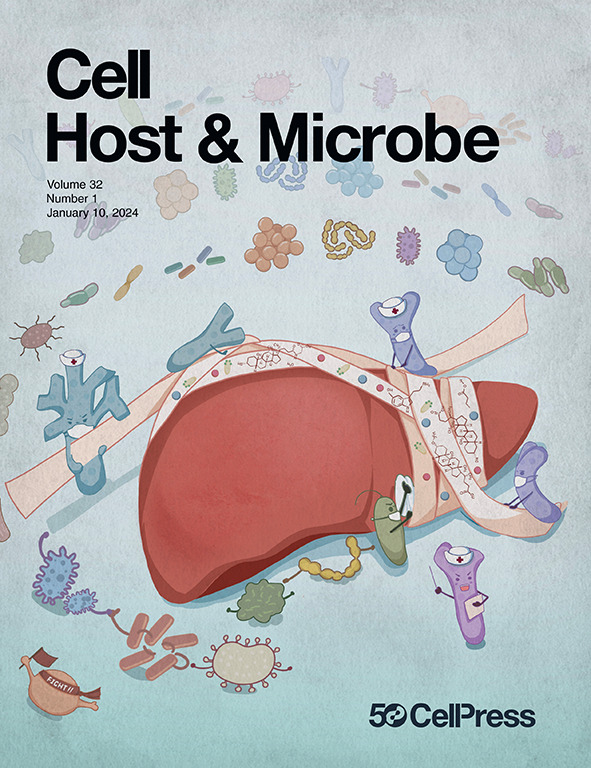Methylglyoxal is an antibacterial effector produced by macrophages during infection
IF 18.7
1区 医学
Q1 MICROBIOLOGY
引用次数: 0
Abstract
Infected macrophages transition into aerobic glycolysis, a metabolic program crucial for controlling bacterial infection. However, antimicrobial mechanisms supported by aerobic glycolysis are unclear. Methylglyoxal is a highly toxic aldehyde that modifies proteins and DNA and is produced as a side product of glycolysis. We show that despite this toxicity, infected macrophages generate high levels of methylglyoxal during aerobic glycolysis while downregulating the detoxification system, including glyoxalase 1 (GLO1). Dampening methylglyoxal generation in mice resulted in enhanced survival of Listeria monocytogenes and Mycobacterium tuberculosis, whereas mice lacking Glo1 have increased methylglyoxal levels and improved infection control. Furthermore, bacteria unable to detoxify methylglyoxal (ΔgloA) exhibit attenuated virulence but are partially rescued in mice that cannot enter glycolysis and generate methylglyoxal. This loss of bacterial GloA results in up to a 1,000-fold greater genomic mutation frequency during infection. Collectively, these results suggest that methylglyoxal is an antimicrobial innate effector that defends against bacterial pathogens.

甲基乙二醛是巨噬细胞在感染过程中产生的抗菌效应物
感染的巨噬细胞转化为有氧糖酵解,这是一种对控制细菌感染至关重要的代谢程序。然而,有氧糖酵解支持的抗菌机制尚不清楚。甲基乙二醛是一种剧毒的醛,可以修饰蛋白质和DNA,是糖酵解的副产物。我们发现,尽管有这种毒性,感染的巨噬细胞在有氧糖酵解过程中产生高水平的甲基乙二醛,同时下调解毒系统,包括乙二醛酶1 (GLO1)。抑制小鼠体内甲基乙二醛的生成导致单核细胞增生李斯特菌和结核分枝杆菌的存活率提高,而缺乏Glo1的小鼠甲基乙二醛水平升高,感染控制得到改善。此外,不能解毒甲基乙二醛的细菌(ΔgloA)表现出减弱的毒力,但在不能进入糖酵解并产生甲基乙二醛的小鼠中部分获救。这种细菌GloA的损失导致感染期间基因组突变频率增加1000倍。总的来说,这些结果表明甲基乙二醛是一种抗细菌的天然效应物,可以防御细菌病原体。
本文章由计算机程序翻译,如有差异,请以英文原文为准。
求助全文
约1分钟内获得全文
求助全文
来源期刊

Cell host & microbe
生物-微生物学
CiteScore
45.10
自引率
1.70%
发文量
201
审稿时长
4-8 weeks
期刊介绍:
Cell Host & Microbe is a scientific journal that was launched in March 2007. The journal aims to provide a platform for scientists to exchange ideas and concepts related to the study of microbes and their interaction with host organisms at a molecular, cellular, and immune level. It publishes novel findings on a wide range of microorganisms including bacteria, fungi, parasites, and viruses. The journal focuses on the interface between the microbe and its host, whether the host is a vertebrate, invertebrate, or plant, and whether the microbe is pathogenic, non-pathogenic, or commensal. The integrated study of microbes and their interactions with each other, their host, and the cellular environment they inhabit is a unifying theme of the journal. The published work in Cell Host & Microbe is expected to be of exceptional significance within its field and also of interest to researchers in other areas. In addition to primary research articles, the journal features expert analysis, commentary, and reviews on current topics of interest in the field.
 求助内容:
求助内容: 应助结果提醒方式:
应助结果提醒方式:


